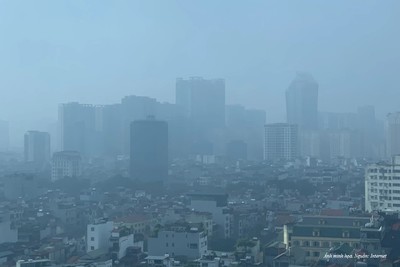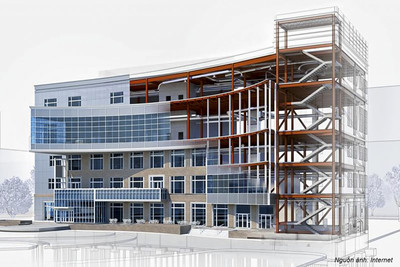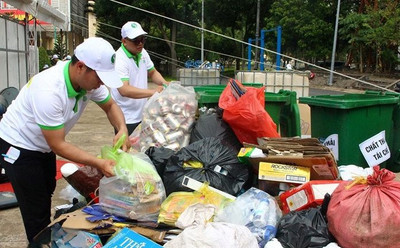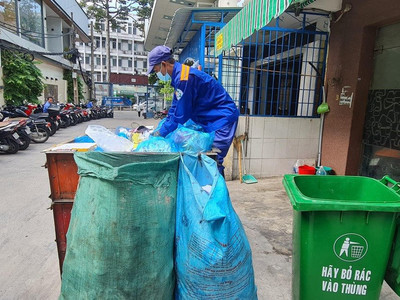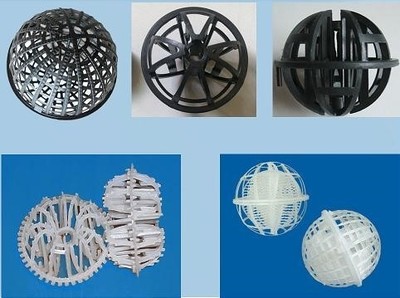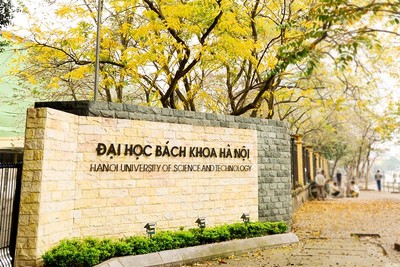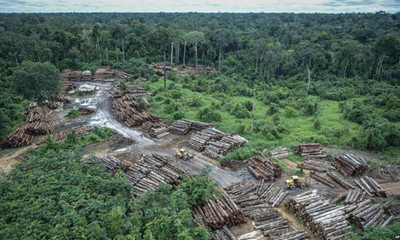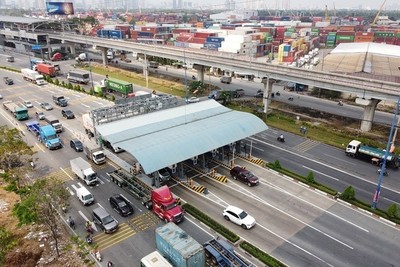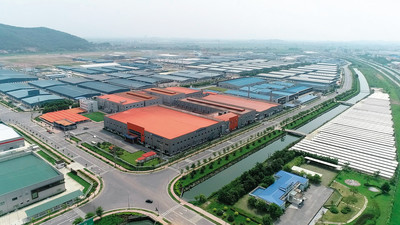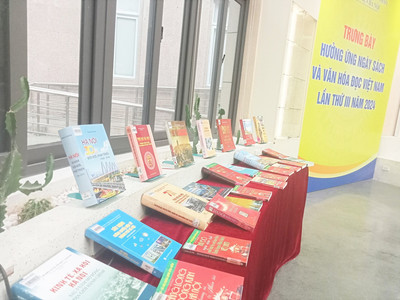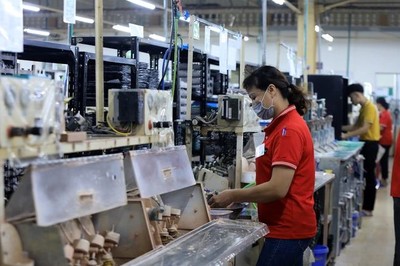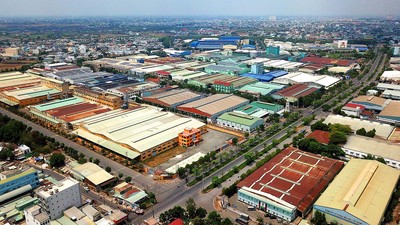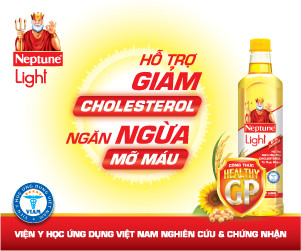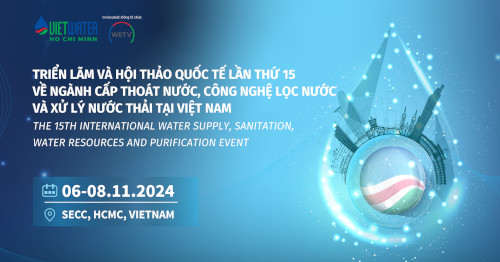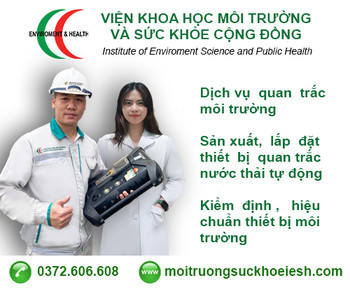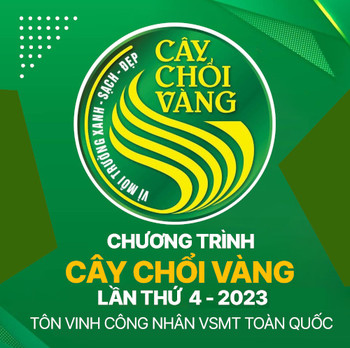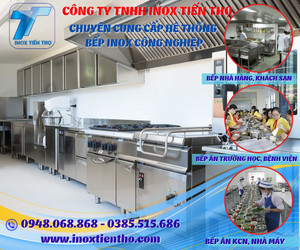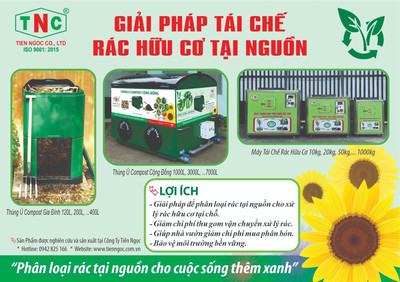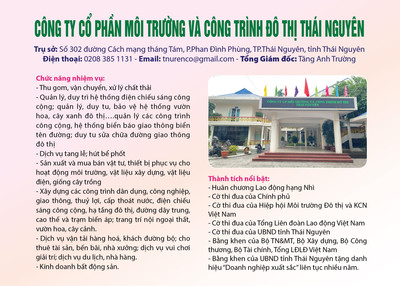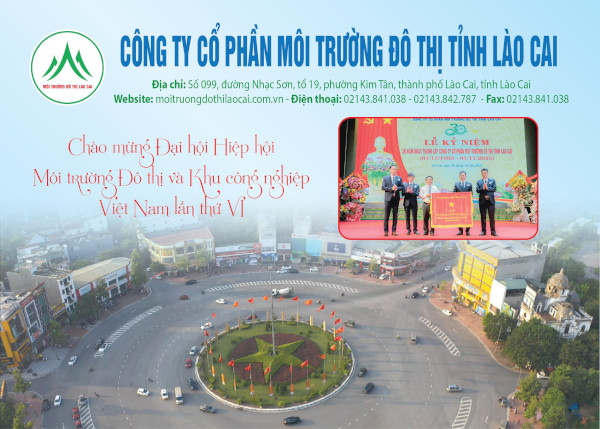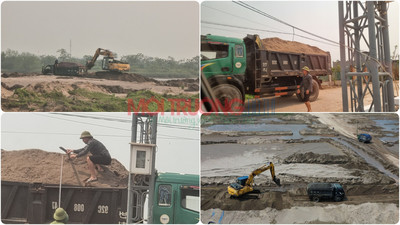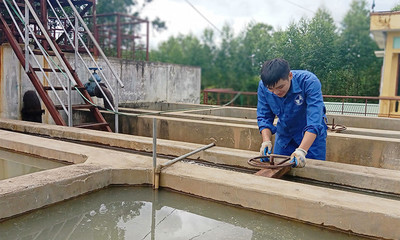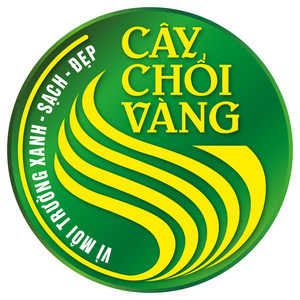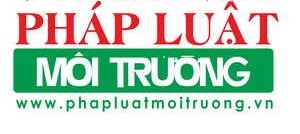Công bố quốc tế trong lĩnh vực kiến trúc, xây dựng, đô thị (Kỳ 7)
Xin giới thiệu tới quý độc giả những nội dung chính của các công bố quốc tế đăng tải trên ScienceDirect và Springer Nature do Cục Thông tin khoa học và công nghệ quốc gia (NASATI) mua quyền truy cập
Trong số này chúng tôi xin giới thiệu tới quý độc giả những nội dung chính của các công bố quốc tế đăng tải trên ScienceDirect và Springer Nature do Cục Thông tin khoa học và công nghệ quốc gia (NASATI) mua quyền truy cập như sau:
 |
Dự án đô thị tại Vân Đồn, Quảng Ninh |
Quy hoạch đô thị:
– Lồng ghép Chương trình nghị sự 2030 trong quản trị đô thị: Áp lực và sự thay đổi thế chế
– Phân tích và trực quan hóa sự thay đổi theo thời gian của các tác động trực quan
– Phân tích không -thời gian các công viên thương mại ở Cape Town, Nam Phi
– Những thách thức đối với việc phát triển không gian bền vững theo quan điểm quốc tế mới – Trường hợp của Montenegro
– Đánh giá thách thức và cơ hội tiếp cận thiên nhiên của các trường học ở Anh
– Đánh giá không -thời gian về sự mở rộng đô thị ở vùng trung lưu sông Dương Tử và tác động của nó đối với vùng đất sinh thái
– MOOSAS – công cụ hỗ trợ thiết kế kiến trúc giai đoạn đầu
Khoa học và công nghệ trong lĩnh vực xây dựng:
– Đánh giá tính chất cơ học và độ bền của bê tông được sản xuất từ rác thải điện tử
– Phương pháp phát hiện sự bất thường trong tiêu thụ năng lượng hằng ngày của hệ thống điều hòa không khí trung tâm
– Khảo sát tính chất cơ lý của vữa sản xuất bằng cốt liệu peclit phủ polyme
– Đánh giá tình trạng tòa nhà dựa vào lập mô hình thông tin tòa nhà
– Khung sơ đồ đánh giá vòng đời (LCA) và Hệ thống Đánh giá công trình xanh (GBRS)
– Đặc tính nén của bê tông cốt liệu tự nhiên và tái chế trong và sau khi tiếp xúc với nhiệt độ cao
– Đánh giá quan trọng về các chiến lược giảm thiểu co ngót do sấy đối với vật liệu làm từ xi măng
Vật liệu xây dựng:
– Sử dụng bột thủy tinh thải để thay thế một phần xi măng trong vữa xi măng
– Ảnh hưởng của sợi sisal đến hiệu suất cơ học của bê tông hiệu suất cực cao
– Tăng cườn độ bền của khối bê tông thô bằng lưới thép mạ kẽm và các tấm CFRP trong điều kiện môi trường khắc nghiệt
– Cải thiện cốt liệu thô tái chế bằng cách tráng/ngâm trước bằng bột zeolit/canxi hydroxit
– Ảnh hưởng của sợi phế thải tổng hợp đến độ co ngót do sấy và các tính chất cơ học của vật liệu không nung
– Ảnh hưởng của tấm nano graphene và tấm graphite đến các đặc tính hóa lý của composite gốc xi măng thông minh
– Thay thế một phần xi măng pooclăng bằng tro than và tro trấu trong bê tông thoát nước
Xin trân trọng giới thiệu!
QUY HOẠCH ĐÔ THỊ
1. Integrating the 2030 Agenda at the municipal level: Multilevel pressures and institutional shift
Land Use Policy, Volume 105, June 2021, 105424
Abstract:
Purpose
The integration of environmental principles into the public decision-making process has been a public policy priority during the last 30 years. However, 5 years after the development of the UN 2030 Agenda, such integration is still at an initial stage, with no significant actions having been implemented either at the national or local level. This paper presents the experience of the municipality of Lucca, which found itself under pressure from the Fridays For Future movement (FFF) that requested the city take urgent action on climate change. In the framework of this initiative, the study aims to answer the following question: based on pressures emerging from social and institutional context, how to institutionalize the integration of sustainability principles and SDGs at the municipal level?
Study design/methodological approach
This study has been developed as research practice. In an attempt to enrich the public decision-making approach with the systematic integration of environmental and sustainable principles, the method, the results provided, and the knowledge created are linked to the action research (AR) framework.
Findings
Within the institutional theory framework and viewing the city as a viable system, the study makes three distinct contributions. First, from a theoretical point of view, the case analyzes the impact of an activist group using its relative power. Second, the study proposes a model for the systematic integration of sustainability principles with municipal practices as a tool of institutional change. Third, from an empirical standpoint, it identifies the UN 2030 Agenda as a governance tool of a municipality.
Originality
The study, for the first time, analyzes the application of a global policy at the local level, thanks to the pressure of a local group of organized citizens that has a global impact.
Limitation
The primary limitation of the study is the lack of comparison with other contexts and municipalities. Limitations in the applicability of the designed model to other contexts are linked to the nature of the city in which it has been developed. The model is the result of action-research and in this sense, it is necessary and desirable that future studies embrace the application of this particular research method to modify and improve it.
2. Spatial effects in the socioeconomic valuation of peri-urban ecosystems restoration
Land Use Policy, Volume 105, June 2021, 105426
Abstract:
In many cities, urban pressure is deteriorating peri-urban ecosystems, despite their high capacity to provide ecosystem services. Against this pressure, restoration projects are being developed to improve the environmental conditions of peri-urban ecosystems. The aim of this work is to determine the economic value and degree of acceptability of a restoration project, the Murcia-Río project, analysing spatial effects. This dimension is incorporated when estimating the willingness to pay (WTP) for the project and when dealing with protest behaviour (PB). A survey was carried out to 401 households in Murcia city (SE-Spain) using the contingent valuation method to obtain a monetary value for the project. We identify that distance to both the project area and substitute areas explain WTP and PB. Based on these findings, we recommend that, to maximize the benefits of such actions, interventions should be targeted to areas with high accessibility and low number of substitutes.
3. Residential green space types, allergy symptoms and mental health in a cohort of tree pollen allergy patients
Landscape and Urban Planning, Volume 210, June 2021, 104070
Exposure to green space is often found to improve human physical and mental health (Aerts et al., 2018Aerts et al., 2018, Fong et al., 2018, Twohig-Bennett and Jones, 2018). Exposure and proximity to green space has been associated with higher birth weights (Agay-Shay et al., 2014), lower blood pressure (Grazuleviciene et al., 2014), reduced risk in diabetes (Dalton et al., 2016), lower risks of prostate cancer (Demoury et al., 2017), lower risk of psychiatric disorders (Engemann et al., 2019) and better mental health (Bratman et al., 2019). These studies often target vulnerable population groups such as pregnant women (Grazuleviciene et al., 2014), elderly people (Dalton et al., 2016), and children (Engemann et al., 2018, Rufo et al., 2019). So far, tree pollen allergy patients, who may experience ecosystem disservices from exposure to green space, are an understudied group.
4. Analysis and visualization of temporal variation in visual impacts
Landscape and Urban Planning, Volume 210, June 2021, 104068
Abstract:
The visual impact of infrastructure in the landscape varies through the day, month to month and over longer time periods. This paper describes the use of time-lapse imagery of a wind farm in Tasmania, Australia to develop time series of modelled visual impacts based on changes in the observed visibility. A number of candidate parameters (maximum, mean, median, percentage of time over given thresholds and impact percentiles), which indicate how visual impact changes over time under prevailing local climatic conditions, were compared. Spatial correlations between the potential indicators were examined and it was found that mean and median best correlate with the other possible measures. For locations with proposed wind farms, monitored visibility levels can be used to create images that correspond to these derived indicator conditions. As it is both easy to explain and highly correlated with all other potential indicators, the median visibility condition appears to be the best condition to be analyzed and visualized, along with the worst case, for use in public discussion. The potential of animated sequences of changing conditions—combining imagery, mapping and graphs over an extended period—is also illustrated and discussed.
5. A Spatio-temporal Analysis of Commercial Parks in Cape Town, South Africa
Urban Forum (2021)
Abstract:
Cities undergo constant change and their industrial spaces are particularly impacted on by new technologies, changing industries and the vagaries of the global and national economies. This paper reports on an investigation of the changing commercial and industrial landscape in Cape Town, South Africa, by focussing on commercial park spaces, specifically those that have been purposely named as business parks, industrial parks and office parks. The study is grounded in the literature on the changing spatial economy of Cape Town. A comprehensive database of commercial parks was created from a host of online sources and documents as well as a field survey. The spatial distribution of commercial parks was analysed in relation to the 11 districts mapped by a previous spatial economic study of the city. It was found that while the commercial parks were predominantly located in four districts, a nuanced locational analysis of the three different types of parks provided evidence of subtle differences in their distribution. The commercial parks are located both in traditional industrial suburbs and in newer commercial spaces and, although most are new developments, some are housed in old industrial spaces that have been converted. Almost half of the commercial parks are managed as sectional title schemes which mirror the management model of gated communities. Purposely named commercial parks are essentially a post-apartheid phenomenon as the majority are post-1994 developments.Optimal land use allocation for the Heathrow opportunity area using multi-objective linear programming
Land Use Policy, Volume 105, June 2021, 105353
Abstract:
The London Plan, the Greater London Authority’s spatial development strategy for London, has defined Heathrow as an Opportunity Area – an area with the capacity to support additional homes and jobs – since 2004, but progress on developing the area has been minimal. Uncertainty around the expansion of Heathrow Airport appears to have adversely affected progress. Nevertheless, the most recent London Plan stipulates that the Heathrow Opportunity Area should accommodate 13,000 new homes and 11,000 new jobs. In this article, multi-objective linear programming is used to investigate whether these figures are achievable given constraints on land availability and land use mix. How land uses might best be assigned to maximise home, job and gross value added (GVA) creation within the Heathrow Opportunity Area is also explored. The main contributions are to provide independent scrutiny of London’s development strategy and to present a mathematical framework for land use allocation planning decisions in urban areas. Findings show that given 700 ha of available land, as indicated in the London Plan, home and job creation figures can be met. However, there is insufficient brownfield land to meet these targets, and development on Green Belt land would very likely be necessary. Strong land use allocations for the area are found to more heavily feature financial and professional services, other office-based businesses, and shops. Rather than presenting a single land use “solution”, results are presented using a wide range of visualisations to illustrate key trade-offs between different goals, with the secondary aim of promoting multi-objective linear programming to planners as a valuable tool to support spatial decisions and policy making.
6. Does surrounding greenness moderate the relationship between apparent temperature and physical activity? Findings from the PHENOTYPE project
Environmental Research, Volume 197, June 2021, 110992
Abstract:
Background
Physical activity can be affected by both meteorological conditions and surrounding greenness, but few studies have evaluated the effects of these environmental factors on physical activity simultaneously. This multi-city comparative study aimed to assess the synergetic effects of apparent temperature and surrounding greenness on physical activity in four European cities. Specifically, we aimed to identify an interaction between surrounding greenness and apparent temperature in the effects on physical activity.
Methods
Data were collected from 352 adult residents of Barcelona (Spain), Stoke-on-Trent (United Kingdom), Doetinchem (The Netherlands), and Kaunas (Lithuania) as part of the PHENOTYPE study. Participants wore a smartphone for seven consecutive days between May–December 2013 and provided additional sociodemographic survey data. Hourly average physical activity (Metabolic Equivalent of Task (MET)) and surrounding greenness (NDVI) were derived from the Calfit mobile application collecting accelerometer and location data. Hourly apparent temperature was calculated from temperature and relative humidity, which were obtained from local meteorological stations along with other meteorological covariates (rainfall, windspeed, and sky darkness). We assessed the interaction effects of apparent temperature and surrounding greenness on hourly physical activity for each city using linear mixed models, while adjusting for meteorological, demographic, and time-related variables.
Results
We found significant interactions between apparent temperature and surrounding greenness on hourly physical activity in three of four cities, aside from the coastal city of Barcelona. Significant quadratic effects of apparent temperature were found in the highest level of surrounding greenness for Stoke-on-Trent and Doetinchem, with 4% decrease in median MET observed for a 10°C departure from optimal temperature (15.2°C and 14.6°C, respectively). Significant linear effects were found for higher levels of surrounding greenness in Kaunas, whereby an increase of 10°C was associated with ∼4% increase in median MET.
Conclusion
Apparent temperature and surrounding greenness interacted in the effect on hourly physical activity across three of four European cities, with varying effect between cities. While quadratic effects of temperature suggest diminishing levels of physical activity in the highest greenness levels in cities of temperate climates, the variation in surrounding greenness between cities could be further explored, particularly by looking at indoor-outdoor locations. The study findings support the need for evidence-based physical activity promotion and urban design.
7. How does residential segregation affect the spatiotemporal behavior of residents? Evidence from Shanghai
Sustainable Cities and Society, Volume 69, June 2021, 102834
Abstract:
The impact of residential segregation on socio-spatial equity and urban stability is a crucial concern for sustainable urban development. Advances in geographic data, such as mobile signaling data (MSD), provide new opportunities to understand residential segregation in the spatiotemporal context at the traffic analysis zone (TAZ) level. Using recordings of 19.3 million mobile users in Shanghai, we measured the diversity of spatiotemporal behavior among residents living in central urban (RC) and noncentral urban areas (RN). We eliminated the influence of different population densities by the odds ratio (OR). A SARIMA model was formulated to forecast the OR in the central and noncentral urban. The findings suggest that residential segregation can be inferred through the spatial distribution and changes of residents’ activity space. TAZs with high homogeneity levels between RC and RN in central urban declined 83.7 % on the weekend than workdays, while in the noncentral urban increased 149.3 %, which reflected employment−housing spatial mismatch of RN and potential less satisfaction of leisure activities of RC. The periods 12:00−14:00 and 18:00−20:00 were confirmed as having the highest inter-urban mobility in the central and noncentral urban, respectively. The research contributes to understanding the social welfare and sustainable development of Chinese cities.
8. How do urban spatial patterns influence the river cooling effect? A case study of the Huangpu Riverfront in Shanghai, China
Sustainable Cities and Society, Volume 69, June 2021, 102835
Abstract:
Urban rivers play an important role in mitigating the surrounding temperatures, but the contributions of the influencing factors are still unclear. Using remote sensing data captured on summer, this study evaluates the river cooling effect (RCE) of the Huangpu River in the central area of Shanghai, China, and examines the influence of urban spatial patterns on it. We found: (1) the average river cooling intensity (RCI) ranged from 1.72 °C to 9.10 °C, with the mean value being 4.47 °C, and the average river cooling distance (RCD) ranged from 72.57 m to 465.42 m with the mean value being 197.35 m; (2) areas with intensive, irregular-shaped, connected and aggregated buildings tend to receive higher RCE, while areas with greenspace of the same characteristics are likely to weaken this effect; (3) areas with low-rise buildings embrace higher RCI, while high-density roads oriented perpendicular to the river bank contribute to a higher RCD; (4) when controlling other variables, the downwind area could obtain a higher RCI of 1.5 °C and a larger RCD of 1.2 m than the upwind area. These findings provide insights for the practice of climate adaptive planning and design on the urban riverfronts of Shanghai and places with similar environments.
9. Nonlinear and synergistic effects of TOD on urban vibrancy: Applying local explanations for gradient boosting decision tree
Sustainable Cities and Society, Available online 1 June 2021, 103063
Abstract:
Urban vibrancy can facilitate human activities and social interactions, attract capital and talent, enhance competitiveness and creativity, maintain resilience, and finally achieve a sustainable urban development. Theoretically, transit-oriented development (TOD) is beneficial for vibrancy. In practice, TOD implementation does not always lead to vibrant community life. To foster vibrancy around stations, we need to understand relationships between TOD-ness (i.e., the degree to which the current (physical) conditions of station areas meet the standards of TOD) and vibrancy. Empirical studies on this topic are scarce, despite numerous studies on built environment effects on vibrancy. Moreover, these studies are likely to overestimate/underestimate the effects as most of them neglect the pervasive nonlinearity and synergism. This research contributes to the understanding of nonlinear and synergistic effects of TOD on vibrancy by constructing gradient boosting decision tree model using multi-source data from 166 metro station areas in Shenzhen, China. Local explanations for the model indicate that (1) Sufficient bus services, horizontal built-up coverage, and mixed-use buildings are dominant contributors to vibrancy around metro stations; (2) TOD have nonlinear influences on vibrancy; (3) Evident synergistic effects exist among/within TOD dimensions. Practical implications of the findings, such as targeted policies with nuanced planning/design criteria, are further discussed.
10. Challenges of sustainable spatial development in the light of new international perspectives – The case of Montenegro
Land Use Policy, Volume 105, June 2021, 105438
Abstract:
This research focuses on spatial planning as an instrument for achieving sustainable development of Montenegro. The research is conducted in the light of new international perspectives, i.e. newer international documents in the field of spatial planning, as global sources of normative principles, and this is the prism through which the planning systems should be viewed. Montenegro is a developing country facing the challenge of urbanization and the challenge of aligning its planning system with new trends in this area. This research explores the planning system of Montenegro with the aim of achieving sustainable spatial development by applying a new planning system approach that leads to sustainable urban and territorial development. The results of the research suggest that sustainable urban and territorial development can be achieved in the case of Montenegro through planning compact and connected cities and regions, but also through a planning system that needs to be more synchronized with decentralization.
11. Implementation of the spatial plan information package for improving ease of doing business in Indonesian cities
Land Use Policy, Volume 105, June 2021, 105338
Abstract:
Land and space are major driving factors in doing business in urban areas. Cities around the world are performing land management techniques to achieve sustainable urban development. The World Bank acknowledges the importance of land management practices and promotes it as the Ease Of Doing Business (EODB) indicators for a supportive environment for economic activities. In improving a city’s competitiveness, local governments need to establish a reliable Land Administration System to organize unrenewable urban land and spaces and simultaneously reduce information asymmetry between actors. A modernized LAS is needed to accommodate the four functions of land management: land tenure, land value, land-use planning, and land development. The ISO 19152:2012 on Land Administration Domain Model (LADM) standard offers a foundation to establish information interoperability in land management that is crucial in modeling the relationship between people and land (and space), the geometrical components, as well as documented Rights, Responsibilities, and Restrictions (RRRs) in land. To promote the exchange of information between the domains of land administration domain and spatial planning, an extension of LADM, the Spatial Plan Information Package (SP Package), was proposed to support cities organizing information in land management. This article presents the proposed spatial plan information extension to the LADM country profile for Indonesia. This work also develops a proof-of-concept of the package in the two biggest Indonesian cities (Jakarta and Bandung) with adaptation to the current national data management policies. Our research shows positive results on making the LADM country profile reflect on the real condition and improving LAS’s adaptability to be integrated with the Spatial Information Infrastructure.
12. Access to urban activities during the Covid-19 pandemic and impacts on urban mobility: the Brazilian context
Transport Policy, Available online 1 June 2021
Abstract:
Social distancing has been adopted as a strategy to contain the advance of the pandemic until specific solutions to combat the virus are available. Many economic sectors and social activities need to continue despite the viruses, and most social distancing policies disregard individual choices, resulting in greater or lesser adherence to isolation. In this paper, we characterize the differentiation of access to essential activities within Brazilian cities during social distancing and the intention to maintain behavior changes concerning these activities in the post-pandemic period. The results showed that the behavior regarding essential activities during the pandemic is not independent of variables associated with pre-pandemic travel patterns, isolation conditions, and socioeconomic factors. Post-pandemic intention proved to be statistically dependent on factors associated with the activities’ characteristics and experiences during the pandemic. Accessibility-oriented planning can guide urban and transportation policies more equitably through the identification of the most affected groups by activity disruption. At the same time, the incorporation of new routines less dependent on displacement offers opportunities to review public space.
13. A study of the impact of major Urban Heat Island factors in a hot climate courtyard: The case of the University of Sharjah, UAE
Sustainable Cities and Society, Volume 69, June 2021, 102844
Abstract:
Urban development in urban areas accommodates a high concentration of human activities. The constant state of evolution in these urban areas is accompanied by environmental problems, including the formation of the Urban Heat Island effect (UHI), where the air is hotter than in rural areas. This research investigates where they occur the factors that contribute to the UHI by reviewing the previous literature on the subject and dividing the factors according to what has created them: 1) the wider environment, 2) their general urban surroundings, and 3) the specific buildings around them. Locally, it has been found that very few publications have covered the factors that compose UHI. Therefore, this study aims to support previous literature on this subject by adopting a novel approach and using two research methods to rank the most important UHI factors. In the first stage of the study, on the subjective basis of experts’ opinions, the Analytical Hierarchy Process (AHP) was used to rank the UHI factors and, thus, identify the most important factor in each category. In the second stage of the study, this process was extended to test the hierarchy of UHI factors in an existing courtyard, which included most of the relevant factors in its design and construction. After developing proposed scenarios in the courtyard, ENVI-met simulation software was used to test and evaluate each factor. The scenarios were developed around factors from the building category and this resulted in another ranking, based on each factor’s contribution to reducing the surface temperature. The more effective factors were together applied to three optimized scenarios and finally the outdoor surface temperature was reduced by 2.45 °C, partly by the best combination of the most effective factors to be identified.
14. Characteristics of noise complaints and the associations with urban morphology: A comparison across densities
Environmental Research, Volume 197, June 2021, 111045
Abstract:
This study aimed to characterise spatial-temporal distribution of noise complaints across urban areas with different densities and to analyse the associations between urban morphology and noise complaints. Taking New York City as the study area, crowdsourced noise complaint and urban morphology datasets from the government’s open data source were statistically analysed. The results suggest that between boroughs the characteristics of noise complaints are different, in terms of their spatial-temporal distribution, their relation to transport network, land use, and building morphology. Noise complaints were clustered around the highest density area (Manhattan). The rate of noise complaints showed a year-on-year increase, peaking in autumn and spring. The rate of noise complaints is higher in areas with higher densities and roads that are 20–40 m wide, closer to road crossings, and in enclosed blocks. The relationships between noise complaints and urban morphology are weaker in high-density boroughs than in other boroughs.
15. Assessing challenges and opportunities for schools’ access to nature in England
Urban Forestry & Urban Greening, Volume 61, June 2021, 127097
Abstract:
Regular access to natural environments has been shown to have beneficial effects on children’s health, development and academic attainment. This study assesses the current capacity for English primary schools to provide access to nature, and the opportunities and challenges of doing so. Using a mixed-methods approach combining questionnaires delivered at schools across England, semi-structured interviews with school staff, and GIS and cloud-based distance analysis between schools and nearby green spaces we found that children’s access to nature through trips to off-site locations is limited by several factors, including the cost of transport. Even when schools are within walking distance to green spaces or had access to such spaces on the school site, factors such as the pressure of delivering the National Curriculum and teachers’ lack of engagement with outdoor learning may limit opportunities to access nature. These findings suggest that urban planning initiatives to create more urban green spaces should be accompanied by measures to reduce the non-spatial limitations to access.
16. Spatio-temporal Evaluation of the Urban Agglomeration Expansion in the Middle Reaches of the Yangtze River and Its Impact on Ecological Lands
Science of The Total Environment, Available online 1 June 2021, 148150
Abstract:
In developing countries, urban agglomerations have become one of the most important carriers of urbanization. In China, one of the largest national urban agglomerations is the UAMRYR (urban agglomeration in the middle reaches of the Yangtze River), which has the fastest urban development in Central China and is home to critical ecological spaces. On this basis, this study analyzed the urban expansion and loss of ecological lands in UAMRYR by establishing a spatial database, grid system, rose maps, and scenario simulation. The highlights of results are as follows: the urban expansion of UAMRYR includes four stages of development: steady growth, accelerated development, peak, and deceleration. Polarized development has occurred in the region, with the Wuhan, Changsha-Zhuzhou-Xiangtan, and Nanchang metropolitan areas having high levels of urban expansion while the other cities have varying levels of urban growth. The loss of ecological land was found to have a highly similar curve and spatial distribution with the urban growth. In terms of ecological land types, the loss of agricultural land accounted for more than half of ecological lands lost overall. Losses in forests, grasslands, wetlands, and water areas varied for different areas, depending on particular conditions and specific environmental characteristics of the city. The three metropolitan areas experienced the highest increases in urban built-up areas; they also had the highest loss of ecological land, which can have critical consequences given their proximity to the Yangtze River, Poyang Lake, Dongting Lake, and other important environmental sensitive areas. The simulation results show that the UAMRYR is projected to maintain a rapid expansion rate from 2020 to 2030. If the urban expansion, particularly in the metropolitan areas, is not managed well and controlled, serious ecological damage could be inflicted on the Yangtze River Basin.
17. Long-term association between urban air ventilation and mortality in Hong Kong
Environmental Research, Volume 197, June 2021, 111000
Abstract:
While associations between population health outcomes and some urban design characteristics, such as green space, urban heat islands (UHI), and walkability, have been well studied, no prior studies have examined the association of urban air ventilation and health outcomes. This study used data from Hong Kong, a densely populated city, to explore the association between urban air ventilation and mortality during 2008–2014. Frontal area density (FAD), was used to measure urban ventilation, with higher FAD indicating poorer ventilation, due to structures blocking wind penetration. Negative binomial regression models were constructed to regress mortality counts for each 5-year age group, gender, and small area group, on small area level variables including green space density, population density and socioeconomic indicators. An interquartile range increase in FAD was significantly associated with a 10% (95% confidence interval (CI) 2%–19%, p = 0.019) increase in all-cause mortality and a 21% (95% CI: 2%–45%, p = 0.030) increase in asthma mortality, and non-significantly associated with a 9% (95% CI: 1%–19%, p = 0.073) in cardio-respiratory mortality. Better urban ventilation can help disperse vehicle-related pollutants and allow moderation of UHIs, and for a coastal city may allow moderation of cold temperatures. Urban planning should take ventilation into account. Further studies on urban ventilation and health outcomes from different settings are needed.
18. Equity in green and blue spaces availability in Singapore
Landscape and Urban Planning, Volume 210, June 2021, 104083
Natural settings in cities have been shown to foster many facets of human wellbeing. For example, they have been associated with higher rates of physical activity, greater social cohesion, reduced myopia, reduced mortality, and lower levels of anxiety. Exposure to nature as a preventive therapeutic intervention has increasingly been recognized and formalized as science-based medical approaches such as forest bathing. A recent study reported significantly better health and subjective wellbeing for people who receive a weekly contact with nature for at least 120 min. With 55% of the global population currently living in cities, urban green and blue spaces can deliver substantial psychological and physical well-being benefits to urban residents.
19. Effectiveness of one-click feedback of building energy efficiency in supporting early-stage architecture design: An experimental study
Building and Environment, Volume 196, June 2021, 107780
Abstract:
As early-stage design decisions are critical to building energy efficiency, performance-oriented design supporting methods have been intensively investigated using various cutting-edge technologies. However, applying such methods in real design scenarios is rather limited, causing their actual effectiveness remains questionable. To address this problem, a design experiment is reported in this paper, where 41 designers conducted the early-stage design of an office building, first without, and then with the help of MOOSAS, a user-friendly tool providing rapid predictions of building energy efficiency. The results showed that after the use of MOOSAS, the energy efficiency of the design outcomes improved significantly, with the mean energy use intensity decreasing by 10%. Moreover, participants reached new design possibilities with higher energy efficiency during their design explorations, and had a better chance to choose the “optimal” or “near-optimal” design from their intermediate options. Other positive changes in the design process included a greater variety of design explorations, the achievement of an upward trend in energy efficiency, and more comprehensive coverage of the early-stage design subthemes. The questionnaire following the experiment showed that 76% of the participants regarded MOOSAS as effective or even very effective, whereas 56% claimed to use MOOSAS voluntarily in the future. It is further implied that a more hands-on educational approach in building science courses could be advantageous, while forming a culture of regarding building performance as architects’ responsibility and using the supporting tools in the pre-design stage may benefit the design practice.
20. Characteristics of noise complaints and the associations with urban morphology: A comparison across densities
Environmental Research, Volume 197, June 2021, 111045
Abstract:
This study aimed to characterise spatial-temporal distribution of noise complaints across urban areas with different densities and to analyse the associations between urban morphology and noise complaints. Taking New York City as the study area, crowdsourced noise complaint and urban morphology datasets from the government’s open data source were statistically analysed. The results suggest that between boroughs the characteristics of noise complaints are different, in terms of their spatial-temporal distribution, their relation to transport network, land use, and building morphology. Noise complaints were clustered around the highest density area (Manhattan). The rate of noise complaints showed a year-on-year increase, peaking in autumn and spring. The rate of noise complaints is higher in areas with higher densities and roads that are 20–40 m wide, closer to road crossings, and in enclosed blocks. The relationships between noise complaints and urban morphology are weaker in high-density boroughs than in other boroughs.
21. A study of the impact of major Urban Heat Island factors in a hot climate courtyard: The case of the University of Sharjah, UAE
Sustainable Cities and Society, Volume 69, June 2021, 102844
Abstract:
Urban development in urban areas accommodates a high concentration of human activities. The constant state of evolution in these urban areas is accompanied by environmental problems, including the formation of the Urban Heat Island effect (UHI), where the air is hotter than in rural areas. This research investigates where they occur the factors that contribute to the UHI by reviewing the previous literature on the subject and dividing the factors according to what has created them: 1) the wider environment, 2) their general urban surroundings, and 3) the specific buildings around them. Locally, it has been found that very few publications have covered the factors that compose UHI. Therefore, this study aims to support previous literature on this subject by adopting a novel approach and using two research methods to rank the most important UHI factors. In the first stage of the study, on the subjective basis of experts’ opinions, the Analytical Hierarchy Process (AHP) was used to rank the UHI factors and, thus, identify the most important factor in each category. In the second stage of the study, this process was extended to test the hierarchy of UHI factors in an existing courtyard, which included most of the relevant factors in its design and construction. After developing proposed scenarios in the courtyard, ENVI-met simulation software was used to test and evaluate each factor. The scenarios were developed around factors from the building category and this resulted in another ranking, based on each factor’s contribution to reducing the surface temperature. The more effective factors were together applied to three optimized scenarios and finally the outdoor surface temperature was reduced by 2.45 °C, partly by the best combination of the most effective factors to be identified.
KHOA HỌC VÀ CÔNG NGHỆ TRONG LĨNH VỰC XÂY DỰNG
1. Kinematics of the retractable roofing module constructed from three roof panels
Journal of Building Engineering, Volume 38, June 2021, 102169
Abstract:
Retractable roof modules in existing constructions consist of one or two roof panels driven by one drive unit. Usually, the Class II mechanisms used are in the form of a four-bar linkage, whose task is to absorb sudden surges in wind. The pre-set objective sought new solutions that would allow the implementation of roof modules with an increased number of panels, for example, three or more. The movement of the mechanisms is strictly defined; therefore, the focus was on their use as a movable skeleton for roof panels. The research problems involved the realisation in terms of geometry, kinematics, and production technology that would ensure efficient opening and closing of the roof module. The main research methods used were simulation and modelling. A structural analysis was carried out for the research models based on parametric modelling, which allowed for their multiple modifications. Virtual modules were subjected to real-time kinematic analysis. One case was selected for which the lengths of the roof panels, their angular acceleration, and velocities were determined. The design concept for roofing based on European design standards and solutions used in the structures of single-girder top-mounted cranes was presented. Received a roof module consist of two articulated four-bar linkages and it provides 95% of open space. One bogie drive sets three roof panels in motion; two of them have the same length, and the panel connected to the drive is 20% longer. The coverage span of the roof is 2.94 times that of the panel length. The roof module was compared with the existing Wimbledon Centre Court (UK) structure, in which the module consists of two roof panels of equal length. The coverage span under the module is 1.97 of the panel length. The obtained in research solution provides twice the coverage span, which is 3.94 of the panel length.
Research has shown that it is possible to obtain retractable roofs that cover larger spaces by using, for example, a smaller number of driving mechanisms or lattice girders. Consequently, this can lead to lighter constructions and is thus more economical. The structure can be used more widely as a movable wall, protecting against heating the interior of the building or as a frame for a photovoltaic panels that follows the movement of the sun.
2. Experimental study on the freezing resistance and microstructure of alkali-activated slag in the presence of rice husk ash
Journal of Building Engineering, Volume 38, June 2021, 102173
Abstract:
This study illustrates the significant influences of rice husk ash (RHA) addition on the mechanical properties, freezing resistance and microstructure of alkali-activated slag (AAS) material. The results indicate that the incorporation of rice husk ash enhanced the compressive strength, and reduced the mass loss percentage and compressive strength loss percentage during freeze-thaw cycles, improving the freezing resistance of hardened AAS pastes evidently. The primary reasons for this optimization are the synergistic functions from the potential filling effect of RHA particles and gels enrichment in nature and content of AAS samples. The former refined the capillary pores definitely and the later was responsible for the development of compressive strength. However, the excessive contents (more than 20%) of rice husk ash did make a side effect on the development of freezing resistance and microstructure of AAS samples, which was likely related to the structure of rice husk ash itself. The dosage of rice husk ash used in AAS should be within 20% when considering the achievement of better comprehensive properties.
3. An experimental study on the mechanical and durability properties assessment of E-waste concrete
Journal of Building Engineering, Volume 38, June 2021, 102177
Abstract:
Electronic waste (E-waste) is increasing constantly around the globe, affecting human health and the environment adversely. To cope with the alarming situation of E-waste production, it is essential to find its potential applications and limit its adverse environmental impacts. This study aims to examine the influence of E-waste as a partial replacement of natural coarse aggregates (NCA) on both the fresh and hardened concrete properties. Four types of concrete mix with manufactured plastic aggregate as a partial substitute for NCA prepared with substitution levels up to 20% (by weight of NCA). The mechanical performance of E-waste concrete was assessed based on the compressive and splitting tensile strength test results and the durability characteristics were evaluated via thermal exposure, sorptivity coefficient, ultrasonic pulse velocity (UPV), abrasion resistance, and alternate wetting and drying. The results revealed that the compressive and tensile strengths of E-waste concrete reduced in the range of 6.3%–17.1% and 23.5%–32.4%, respectively for replacement ratios of 10%–20%. However, the workability and durability properties improved with the E-waste aggregate incorporation. A substantial reduction in the sorptivity coefficient, UPV value, and abrasion loss was observed with an increasing amount of E-waste aggregates. Furthermore, concrete with E-waste aggregates showed better performance against alternate wetting and drying cycles compared to normal concrete and the increasing percentage of E-waste had no substantial effect on the drop in the compressive strength of E-waste concrete against thermal exposure.
4. Light transmittance performance of sustainable translucent self-compacting concrete
Journal of Building Engineering, Volume 38, June 2021, 102178
Abstract:
Translucent self-compacting concrete (TSCC) is an innovative energy-saving construction material. TSCC was prepared by Portland cement, limestone powder, silica fume, coarse aggregate, fine aggregate, water, superplasticizer, and plastic optical fibers (POF) to allow inward sunlight transmission. This research investigates the compressive strength as well as the natural and artificial light transmittance performance of TSCC containing different POF volume ratios and diameters. The natural light transmittance performance investigated at natural light conditions from 7 a.m. to 7 p.m. The artificial light transmittance performance was analyzed at voltage variation, light source variation, using a group of light-dependent resistors (LDRs) instead of single LDR and varying the distances from light source to specimen. TSCC was also compared with that of translucent self-compacting mortar (TSCM) and it was found that the artificial light transmittance performance of TSCC was somewhat similar to that of TSCM. The experimental study showed that although the compressive strength increased with increasing POF volume ratios and diameters, the light transmittance significantly increased in a direct quadratic relationship with increasing POF volume ratios. In this research, TSCC performs up to 21.35% and 24.7% of natural and artificial light transmittance near-cube face, respectively, which is enough lighting for commercial and residential buildings.
5. Anomaly detection method of daily energy consumption patterns for central air conditioning systems
Journal of Building Engineering, Volume 38, June 2021, 102179
Abstract:
Anomaly detection of operating patterns of complex systems is an important measure to achieve building energy conservation. In this paper, a low-cost anomaly detection method is proposed to identify the anomaly energy consumption patterns of central air conditioning systems (CACS). The complex process of anomaly detection is simplified as a binary classification problem without threshold. And information entropy is used as the characteristic parameter of daily energy consumption patterns (DECP) while traditional characteristic parameters are prone to cause high miss rates or false-positive rates due to the large data fluctuation, numerous influence factors and complex operational parameters of the complex systems. Moreover, three main influence factors are analyzed to divide the complex operating conditions of CACS and the normal DECPs data-set is updated online to improve the accuracy of the abnormal patterns detection. This non-threshold detection method is also verified by site survey which indicates that the detection accuracy is higher than the traditional detection method based on conventional characteristic parameters and regular K-Means clustering method.
6. Obtaining the strength parameters of concrete using drilling data
Journal of Building Engineering, Volume 38, June 2021, 102181
Abstract:
Nowadays, finding a novel and easy accessible method to estimate the uniaxial strength of concrete is of utmost importance in the construction industry. The uniaxial or unconfined compressive strength (UCS) test is a conventional method for determining the compressive strength of concrete. In this research, a non-destructive method based on surface drilling on concrete is provided. Strength parameters such as the internal angle of friction and cohesion were obtained using an analytical model based on the partial equilibrium of the operating forces in the drilling process. Data, such as drilling power, speed, torque and penetration rate were all acquired from a drilling machine designed and built. Evaluating the effect of additional parameters such as the crushed zone and contact friction in the drilling process is what makes this analytical model superior to the previous models. Accurate results have been obtained by applying this method to rock samples. For this study, the new method was applied concrete samples with a maximum grain size of 0.6–12.5 mm. The method’s performance and accuracy were assessed based on the conventional UCS method. While using an appropriate drill diameter, this method gives highly accurate results with an estimated error of below 10%. In the surface drilling method, a handful of holes with about 25 mm depth are created on the concrete surface at regular distance-intervals. The strength parameters of concrete are then calculated using linear fitting and data obtained from the drilling operation, including drilling power, speed, torque, and penetration rate. This can be utilized as a non-destructive method to determine various strength parameters and unconfined compressive strength of concrete due to its accuracy and precision.
7. Investigation of physical and mechanical properties of mortars produced by polymer coated perlite aggregate
Journal of Building Engineering, Volume 38, June 2021, 102182
Abstract:
With its low unit weight, expanded perlite (EP) offers significant advantages in heat and sound insulation in the construction sector. However, due to its high-water absorption capacity, EP affects the physical and mechanical properties of concrete negatively. Therefore, it is aimed to reduce water absorption by coating the EP with polymer and thus to improve its mechanical and physical properties. In this study, mortar production was carried out by replacing coated and uncoated EP with CEN reference sand at 0%, 20%, 40%, 60%, and 80% respectively. The effective water/cement ratio of all produced mortar samples was determined to be 0.6. For coated and uncoated EP aggregate mortar series, unit weight, compressive strength, bending tensile strength, water absorption, ultrasonic pulse velocity (UPV), and thermal conductivity coefficient were determined. The results showed that the unit weight of the mortar samples decreased as the amount of EP increased, but their physical and mechanical properties also changed. Mortar samples with better thermal insulation properties were obtained with decreasing thermal conductivity values. The polymer coating of EP improved physical and mechanical properties. Especially in the 80% substituted EP series, the thermal conductivity decreased from 1.20 to a coefficient of 0.91 W/mK.
8. Post-impact residual strength and resilience of sandwich panels with natural fiber composite faces
Journal of Building Engineering, Volume 38, June 2021, 102184
Abstract:
In this paper, the post-impact residual flexural behavior of sandwich panels with flax fiber-reinforced polymer (FFRP) faces and polyisocyanurate (PIR) foam cores is investigated experimentally. The faces were manufactured using a wet lay-up procedure with a balanced bidirectional 2×2 twill flax fiber fabric and a bio-based epoxy with a bio-content of 30%. Each specimen was 1200 mm long x 75 mm wide x 80 mm thick. The main parameters in the study were the face thickness (one, two or three FFRP layers, representing core-to-skin thickness ratios of approximately 54, 28 and 20) and core density (32, 64 or 96 kg/m3); a total of nine combinations. In this study, 27 specimens (three specimens for each combination) were tested under impact loads and the surviving specimens were tested under monotonic three-point bending. Each of the three identical specimens was tested under different impact condition, namely 100%, 75% and 50% of the energy resistance of an intact specimen, with the last two impacted 50 times. The results of the post-impact residual flexural tests were compared to three-point bending tests of intact specimens. The beams demonstrated remarkable resilience in that the impact events did not have a negative effect on their flexural strength or stiffness. In fact, those tested at higher energy levels exhibited a slight increase in strength after impacts. This shows their suitability for use in infrastructure applications such as building cladding panels, flooring and roofing as they retain their strength and stiffness even after multiple impacts.
9. Utilization of ceramic tile demolition waste as supplementary cementitious material: An early-age investigation
Journal of Building Engineering, Volume 38, June 2021, 102187
Abstract:
Construction and demolition (C&D) activities generate large amounts of waste, such as ceramic tile demolition waste (CTDW). However, the recycling ratio of C&D waste is generally of 3–10%. In this work, pastes with 0–30 wt% replacement of Portland cement by CTDW and limestone (reference filler) were produced. The particle packing, fresh-state properties (mini slump and rheometry), cement hydration (isothermal calorimetry and in situ X-ray diffraction – XRD) and compressive strength of the pastes were evaluated. The results showed that CTDW incorporation reduced the inter particle distance of the system while limestone increased it. Consequently, CTDW incorporation progressively increased the static yield stress and viscosity of paste while reducing the mini slump. CTDW enhanced the cement hydration kinetics compared with limestone, increasing the main heat flow peak, 24- and 168-h cumulative heat values by up to 8%, 5% and 6%, respectively, for the same incorporation level. Furthermore, in situ XRD and calorimetry indicated equivalent hydration for CTDW and limestone incorporation up to 8 h, from which the residue led to further alite consumption and hydrates formation (i.e. ettringite and portlandite). Compressive strength results at 1 and 7 days had good agreement with the cumulative heat values, indicating that CTDW led to strengths up to 5% higher than limestone did for the same replacement level and age. No significant pozzolanic reaction by CTDW was observed up to 7 days.
10. Use of fine recycled concrete aggregates in concrete: A critical review
Journal of Building Engineering, Volume 38, June 2021, 102196
Abstract:
This paper discusses the state-of-the-art of the fine recycled concrete aggregates (fRCA), focusing on their physical and chemical properties, engineering properties and durability of concretes with fRCA. Based on the systematic review of the published literature, it is impossible to deduce without any further research the guidelines and tools to introduce the widespread application of the fRCA in new concrete whilst keeping the cement contents at least the same or preferably lower. Namely, what is still missing is knowledge on key physico-chemical properties and their relation to the quality of the concrete mix and the concrete performance. This paper sets the foundations for better understanding the quality of fRCA obtained either from parent concrete specifically produced in the laboratory, with controlled crushing and sieving of the recycled aggregates or from field structures. By comparing properties of fRCA with properties of fine natural aggregates, the key limiting properties of fRCA are identified as the high water absorption of fRCA, moisture state of fRCA, agglomeration of particles and adhered mortar. As such, continuous quality of fRCA is hard to be obtained, even though they may be more continuous in terms of chemistry. Advanced characterization techniques and concrete technology tools are needed to account for limiting properties of fRCA in concrete mix design.
11. Building condition assessment supported by Building Information Modelling
Journal of Building Engineering, Volume 38, June 2021, 102186
Abstract:
The buildings natural ageing along with the absence of planned maintenance actions and the effects of climate changes accelerate the building materials degradation. So, to extend the materials’ service life, the application of appropriate maintenance actions is imperative. This work aims to assess the building performance and to prioritize the maintenance actions employing Key Performance Indicators using Building Information Modelling-(BIM) as a supporting tool for Building Condition Assessment-(BCA) and maintenance management. To achieve these goals a methodology was proposed and applied to a case study involving 1) Building data collection; 2) Building Life Cycle Cost estimation, and 3) Automated calculation of Building Performance Indicator. This research application highlights the importance of BIM role in buildings’ Facility Management, allowing the model’s permanent update of information, in this case for BCA purposes. It also has high potential to prioritize the building maintenance actions, extending its materials service life, which contribute to attain a sustainable built environment.
12. Conceptual design of integrated seismic and energy retrofit interventions
Journal of Building Engineering, Volume 38, June 2021, 102190
Abstract:
Nowadays, most of the Italian existing reinforced concrete (RC) buildings have become obsolescent and not compliant with modern requirements in terms of seismic safety, energy efficiency and living comfort. Many of them require a deep renovation to comply with minimum acceptable targets. In the last decade, major economic resources have been invested for the reduction of energy consumption and polluting emissions, while neglecting structural safety. Recent Italian seismic events brought out the high seismic vulnerability of residential and school buildings, which exhibited severe damage or collapse, thereby yielding significant social and economic losses. Therefore, an effective renovation process should consider, simultaneously, both structural and energy aspects.
This research work presents a novel conceptual design methodology for the integrated structural and energy retrofit of existing RC buildings. It allows the definition of incremental strategies for integrated retrofit solutions with an increasing impact while taking into account overall structural and energy performances, costs and benefits. The applicability of the proposed methodology is illustrated with reference to two case studies RC buildings. The outcomes of this study can be used to help the stakeholders for the selection of the most effective and compatible retrofit solutions for a given set of performance targets.
13. Experimental and analytical investigation on flexural behaviour of glulam-concrete composite beams with interlayer
Journal of Building Engineering, Volume 38, June 2021, 102193
Abstract:
In various practical applications of timber-concrete composite (TCC) beams, particularly for the rehabilitation of timber buildings, there is a timber board interlayer at the interface. The timber board is applied as the formwork for the pouring of concrete slab and usually left behind as part of the composite structure. There are few investigations performed on the mechanical behaviour of TCC beams with timber board interlayer. In this paper, two full-scale glulam-concrete composite beams with inclined crossing screws and notched connectors were constructed and loaded by four-point bending to investigate the flexural performance of composite beams with timber board interlayer. Experimental results demonstrated that the failure mechanism of the composite beam was combined bending and tensile failure of the glulam beam. Due to the flexibility of the shear connector, relative slip occurred at the interface and the assumption of a plane section remaining plane did not hold for the composite cross-section as a unit. Additionally, analytical models for the bending stiffness and load-bearing capacity of TCC beams with interlayer were proposed. Comparisons demonstrated that the bending capacity and stiffness of TCC beams with interlayer could be well predicted using the calculation method.
14. A hybrid seismic isolation system toward more resilient structures: Shaking table experiment and fragility analysis
Journal of Building Engineering, Volume 38, June 2021, 102194
Abstract:
The effectiveness of various vibration control strategies has always been a debate among structural engineers. Seismic base isolation systems and passive dampers are recognized as two of the most economical devices which have passive mechanisms in reducing the structural vibration and responses. To this end, comprehensive biaxial shake table testings have been carried out on a building frame with and without a proposed base isolation system. The proposed device has a novel combined isolation mechanism at the structure’s base. By different methods of testing, natural frequencies and viscous damping for the frame model with and without the proposed system were identified. Both structures were intensively tested under various earthquake motions, and various structural responses were recorded. The experimental results indicated that the newly proposed system is very effective in controlling the vibration of building structures and can be used to increase the seismic resilience metrics. As a complementary investigation, the incremental dynamic analysis (IDA) was conducted to develop the seismic fragility curves under both near-field and far-field strong ground motions (SGMs). The fragility estimations indicated that the proposed system has a higher collapse margin ratio (CMR) compared to conventional fixed-base frames.
15. Recycling biosolids as cement composites in raw, pyrolyzed and ashed forms: A waste utilisation approach to support circular economy
Journal of Building Engineering, Volume 38, June 2021, 102199
Abstract:
Ongoing management of biosolids has emerged as a major economic challenge for wastewater treatment facilities around the world. To tackle this challenge, it becomes imperative for the researcher community to identify various applications for this waste material, simultaneously supporting the government’s closed-loop circular economy initiative. This research investigates the use of biosolids in raw, pyrolyzed (biochar), and ashed (bioash) forms as cement replacement materials. Detailed material characterization was carried out on the raw cementitious material followed by that on the hydrated cement composites using X-ray fluorescence, X-ray diffraction, energy-dispersive X-ray spectroscopy, scanning electron microscopy, carbon, hydrogen, nitrogen, and sulfur (CHNS) analysis, Xray micro-computed tomography and compressive strength test to identify their mechanical and physicochemical properties. The results show that the addition of 10% biosolids in the blended cement composite increased its total porosity by more than 21 times and decreased its compressive strength by 80% at 28 days of curing, indicating its potential use as an air-entraining admixture for the low-density concrete. However, the addition of 10% biochar brought about a strength improvement of ~278% and a reduction in its total porosity by ~87% compared to that of the biosolids blended cement composites. Partial replacement of cement with 10% bioash (ash form) showed ~66% reduction in its total porosity and 11% reduction in the 28-day compressive-strength compared to that of the biochar blended cement composites. Overall, this study demonstrates that the different forms of biosolids (raw, biochar, and bioash) can potentially be used as cement replacement materials with varied benefits in the cement and concrete industry. The recommendation for the future work is to carry out long-term durability studies on these blended cement composites for the ready uptake of this waste material by the construction industry.
16. A schematic framework for Life Cycle Assessment (LCA) and Green Building Rating System (GBRS)
Journal of Building Engineering, Volume 38, June 2021, 102180
Abstract:
Environmental Impact Assessment (EIA) tools link the environmental context of a building to the design decision-making framework. Life Cycle Assessment (LCA) and Green Building Rating Systems (GBRS) are the two approaches commonly used to holistically analyse the environmental performance of the whole building. While GBRS is mostly based on a checklist with many qualitative criteria, LCA compels decision-makers to base the analyses on numerical evidence, facilitating the comparison between design choices. Some GBRS, such as LEED, BREEAM and Green Star, have been incorporating LCA as part of their assessment system. This practice brings transparency to the design process and increases designers’ awareness of the building’s environmental impact. Consequently, this paper aims to develop a schematic EIA framework within the design life cycle, proposing future research directions to support its development. The framework was based in three parallel analyses: (1) comparison between LCA and GBRS assessment methodologies, (2) analysis of the LCA parameters within GBRS, and (3) investigation of LCA software tools focused on buildings that comply with GBRS requirements. The research found that, rather than performing either a GBRS or an LCA, the most appropriate EIA methodology will depend on the design life cycle stage. Graphical outputs and connection with 3D modelling will improve the evaluation of environmental impacts as a process integrated with the design.
17. Direct shear test and cyclic loading test for seismic capacity of dimension stone panel cladding with dowel pin connection
Journal of Building Engineering, Volume 38, June 2021, 102205
Abstract:
In this study, direct shear test and cyclic loading test were performed to investigate the seismic capacity of dimension stone cladding with pin connections. A total of 60 dowel pin connection specimens were tested under direct shear, and 12 panel specimens were tested under quasi-static cyclic lateral loading in the out-of-plane direction of the panel. The major test parameters were type of stone, drilled hole diameter for dowel pin connection, thickness of stone panel, and type of dowel pin. In the direct shear test of dowel pin connection, the tested peak strengths agreed with the results predicted by analogy to the breakout strength in ACI 318. However, the results of cyclic loading test showed that the shear strength of the dowel pin connector was decreased, due to the effect of flexural action under cyclic loading of the panel. On the basis of the direct shear test results and panel test, a stone breakout strength was proposed considering the effect of flexural moment. On the other hand, the flexural strength of the panel was accurately predicted by the cracking moment based on the fracture modulus of stone.
18. The compressive behaviour of natural and recycled aggregate concrete during and after exposure to elevated temperatures
Journal of Building Engineering, Volume 38, June 2021, 102214
Abstract:
Applications of recycled concrete aggregate (RCA) in the production of new concrete can help in addressing the growing solid waste challenge and preserving natural aggregate resources from depletion. The behaviour of RCA concrete under different loading scenarios is a well-studied topic at both material and structural levels. However, little attention has been directed at studying the performance of concrete made with RCA at elevated temperatures. Most of the previous studies have focused on the residual mechanical response of coarse RCA concrete after exposure to elevated temperatures. This paper presents an experimental study on the behaviour of natural aggregate concrete (NAC) and recycled aggregate concrete (RAC) during and after exposure to elevated temperatures. The RAC in this study contained both coarse and fine recycled concrete aggregates (CRCA and FRCA) as partial replacements of natural aggregates. The compressive strength of the NAC and RAC were evaluated at ambient temperature (unheated), after exposure to three different temperatures of 150, 300, and 450 °C (residual), at an elevated temperature of 450 °C without preloading (steady state), and during heating while being preloaded with 40% and 70% of the ambient strength (transient). A rate of 2 °C/min was used in all these heating scenarios. The results indicated that concrete with aggregates partially replaced with CRCA and FRCA exhibited good performance at elevated temperatures, and it can be considered comparable to conventional concrete. The results also showed that the compressive strengths measured during elevated temperatures, with or without preloading, were relatively higher than the residual compressive strengths for both RAC and NAC. The total thermal strains were also investigated with Digital Image Correlation. Preloading had an impact on the evolution of the total thermal strains and the occurrence of spalling for the types of concrete that were tested.
19. Compressive behavior of concrete-filled double skin steel tubular short columns with the elliptical hollow section
Journal of Building Engineering, Volume 38, June 2021, 102200
Abstract:
Recently, many researchers have shown a great interest in single skin concrete-filled steel tubular (CFST) columns with circular and rectangular sections, as well as elliptical sections that contain the performance of both sections. On the other hand, elliptical concrete-filled double skin steel tubular (CFDST) columns are a new member of the CFDST family and developed form of elliptical CFST columns. In the literature, there are a limited number of studies focusing on this new structural element. So, doing both experimental and analytical investigations on the elliptical CFDST column is required to provide an opportunity for its covering in the design codes. Herein, a finite element (FE) method was used to constitute a model for investigating the axial compressive performance of elliptical CFDST short columns. The software ABAQUS was employed to describe the nonlinear behavior of materials and the complex interplay between the steel and concrete components. The developed model was also verified by comparing with the experimental results. Additionally, two widely used design codes (AISC and Eurocode 4) were applied. After verification of the developed FE model, the ultimate axial strength, axial load-displacement curve, failure mode, and stress analysis of elliptical CFDST short columns were studied comparatively. The results indicate that the generated FE model could be employed in the estimation of the behavior of elliptical CFDST short columns. Besides, the parametric study revealed that the thickness of the outer steel tube, steel yield strength, concrete compressive strength, and aspect ratio of the elliptical section exert an influence on the performance of the elliptical CFDST short columns.
20. A critical review on drying shrinkage mitigation strategies in cement-based materials
Journal of Building Engineering, Volume 38, June 2021, 102210
Abstract:
Drying shrinkage deformation due to moisture migration is a major concern in cementitious materials and can lead to a high probability of cracking, resulting in a deterioration in long-term performance and serviceability. In this paper, the primary mechanisms of drying shrinkage, mitigation strategies and the research gaps are elucidated to provide a comprehensive understanding of the factors influencing drying shrinkage and identify research strategies to assist in the development of novel shrinkage-resistant concrete. The use of shrinkage-reducing admixture is identified as the high-efficiency methodology. This reduces the surface tension of the liquid in the capillary pore, resulting in a 20–50% drying shrinkage reduction when applied with a dosage up to 3%. It can achieve even greater efficiency by combining the admixture with expansive agents to provide synergistic effects, giving mitigation of drying shrinkage of up to 80%. Replacing cement with supplementary cementitious materials, up to 35%, is also an effective approach to mitigate drying shrinkage, giving a reduction between 5–42%. The reinforcing effect of novel carbon-nanotubes, albeit at a small dosage (0.1% w.t), can effectively strengthen the C–S–H gel matrix, resulting in a drying shrinkage reduction of 15–21%. Introducing internal restraints using fibres or aggregate also demonstrates high effectiveness for drying shrinkage mitigation. Furthermore, coupled CO2-water curing or coating the concrete surface to prevent moisture loss provides an innovative approach to drying shrinkage reduction at an early age (50–70%). Finally, to avert time-dependent deformation, the use of superplasticizer (less than 1%) based on the polycarboxylate polymer is suggested.
VẬT LIỆU XÂY DỰNG
1. Utilization of waste glass powder as partial replacement of cement for the cementitious grouts with superplasticizer and viscosity modifying agent binary mixtures: Rheological and mechanical performances
Construction and Building Materials, Volume 286, 7 June 2021, 122953
Abstract:
The utilization of waste glass in cement-based grouting materials has attracted a lot of interests due to its ability of improving rheological properties and stability. The purport of this research was to investigate the feasibility of the grouts containing waste glass powder (WGP), superplasticizer (SP), and viscosity modifying agent (VMA). For all testing mixtures, the water to binder ratio was maintained at 0.5. The selected mixtures were used to evaluate properties of mini-slump, marsh cone flow time, thixotropy, bleeding capability, autogenous shrinkage, compressive strength, and flexural strength. The statistical analysis method was adopted to further assess the synergistic effect of WGP, SP, and VMA. The testing results indicated that the use of 15% WGP as cement replacement improved the mini-slump diameter, and marsh cone flow time, in the meantime, decreased yield stress and plastic viscosity. Moreover bleeding capacity and mechanical properties were enhanced simultaneously. The method of Decision Matrix Analysis (DMA) was carried out to comprehensively evaluate and analyze the effect of each component in the grouts, and the results shown that WGP had notably positive effects on the properties of grouts.
2. Shear behavior of single- and triple-thickness masonry panels strengthened by bed-joint structural repointing
Construction and Building Materials, Volume 286, 7 June 2021, 122925
Abstract:
Bed-joint structural repointing is a widely used strengthening technique in historic masonry constructions, particularly in applications where the material appearance needs to be preserved. Despite its wide use, limited research is available on the effectiveness of this technique in masonry elements of greater thickness subjected to in-plane shear loading. In the reported study, the shear behavior of single- and triple-thickness masonry panels strengthened with Near Surface Mounted (NSM) steel bars was investigated. Masonry panels were built following the material characteristics and bonding types of a reference case and tested in diagonal compression. Two lime-based mortar mixes with different compressive strength were employed to assess the effect of existing mortar quality on the strengthening technique performance. The investigated parameters were the number of courses with reinforcement in single-thickness panels, and the depth of the reinforcement and number of the faces reinforced in those of triple-thickness.
The technique proved effective in improving the shear deformation capacity regardless of specimen thickness and, in panels of triple-thickness, both the eccentricity (result of reinforcing one or two faces) and depth of reinforcement were observed to significantly affect shear behavior.
3. Micro and macro-structural effects of high temperatures in Prada limestone: Key factors for future fire-intervention protocols in Tres Ponts Tunnel (Spain)
Construction and Building Materials, Volume 286, 7 June 2021, 122960
Abstract:
Temperature and cooling methods strongly affect the stability of tunnels drilled in rock masses and so condition interventions for fire emergencies. Samples from two horizontal boreholes drilled in Prada limestone during the design stage of the Tres Ponts Tunnel in the Catalan south Pyrenean zone (Spain) are heated from 105 to 600 °C, and subsequently cooled with air or water to simulate fire extinguishing interventions. Changes in chemical composition and microstructure, physical properties (open porosity, volume, dry total weight, P and S-wave velocity), and mechanical properties (uniaxial compressive strength, elastic modulus, and Poisson’s ratio) are analysed. Rock weakening is observed even at low temperatures (T < 300 °C). The influence of the cooling method appeared at intermediate temperatures of 300-400 °C and open porosity, P and S-wave velocities, and elastic modulus show greater variation for water-cooled samples. A temperature of 500 °C is of paramount importance for ‘Prada’ limestone as it leads to a dramatic increase in porosity and a notable decrease in P and S-wave velocities under both cooling methods. Trans-granular micro-crack progression is observed at 500 °C using scanning electron microscope (SEM), and water-cooled samples show a greater loss in uniaxial compressive strength (UCS), and this is due to micro-crack connections and growing fissures. Thermal damage at 600 °C is also greater when samples are quickly cooled. An ANOVA and a simple regression analysis are performed to discard the influence of the natural location of the borehole samples in the obtained experimental results. Finally, correlations to predict UCS and elastic modulus from volume, open porosity, and P-wave velocity after thermal treatment are proposed using simple exponential and potential functions to help make preliminary decisions after a tunnel fire. These predictive results on the effects of fire on Prada limestone will be considered for the definition of future fire intervention protocols in the Tres Ponts Tunnel.
4. Influence of sisal fibers on the mechanical performance of ultra-high performance concretes
Construction and Building Materials, Volume 286, 7 June 2021, 122958
Abstract:
This paper investigated the utilization of natural sisal fibers in ultra-high performance concrete (UHPC). UHPC mixtures containing sisal fibers with different lengths (6, 12, and 18 mm) and volume contents (1.0%, 2.0%, and 3.0%) were prepared. Flowability, mechanical strength, and interfacial bond behavior between fiber and matrix were tested for every mixture. The distribution of sisal fibers in the UHPC matrix was evaluated using the ultraviolet (UV) light and fluorescent whitening agent (FWA). Finally, the microstructures of typical samples were observed by a scanning electron microscope (SEM). Experimental results indicated that the flowability of the fresh UHPC mixture decreased with the increase of length and volume fraction of sisal fibers. The content of 2.0% sisal fibers with a length of 18 mm increased flexural strength and toughness of UHPC by 16.7% and 540.0%, respectively, compared with plain UHPC specimens. The pull-out load and pull-out energy increased with the length of sisal fibers. Moreover, the sisal fibers can be uniformly distributed in the UHPC matrix. Therefore, the utilization of sisal fibers to manufacture a low-cost and low energy-consumption UHPC has great potential.
5. Durability of plain concrete prism strengthened with galvanized steel mesh and CFRP laminates under harsh environmental conditions
Construction and Building Materials, Volume 286, 7 June 2021, 122904
Abstract:
This paper investigates the bond durability of recently developed galvanized steel mesh (GSM) strengthening systems compared to the carbon fiber-reinforced polymer (CFRP) composites under severe environments. Plain concrete prisms notched at the mid-span and strengthened with medium cord density GSM (MSM), high cord density GSM (HSM), and CFRP-epoxy systems were exposed to the laboratory environment, direct sunlight, and saline water for 180, 360, and 730 days. Prisms were tested under three-point bending after each exposure. The failure mode of the CFRP specimens changed from interfacial to pure adhesive after saline-water and sun exposures only after six months, whereas the MSM and HSM specimens exhibited cohesive failure throughout 730 days of all the exposures. After 730 days of conditioning, no significant loss in the bond strength was observed for the three strengthening systems. On the contrary, the strength retention factor was above 1 for several specimens tested after 360 and 730 days under all exposures. Bond-strength environmental degradation factors are proposed to analyze and design the strengthened reinforced concrete members with such laminates.
6. Properties enhancement of recycled coarse aggregates by pre-coating/pre-soaking with zeolite powder/calcium hydroxide
Construction and Building Materials, Volume 286, 7 June 2021, 122888
Abstract:
The reuse of construction and demolition waste by recycling as aggregates can not only protect the environment, but also alleviate the shortage of natural resources. However, the application of recycled aggregates in practical engineering is limited due to their shortcomings, such as the higher crush value and water absorption, and the lower apparent density. In this study, four different treatments were designed to modify recycled coarse aggregates (RCAs) based on zeolite powder (ZP) and calcium hydroxide (CH), which were CH slurry pre-coating, CH solution pre-soaking, zeolite powder-cement (ZP-C) slurry pre-coating and ZP-C solution pre-soaking, respectively. Moreover, the macro-properties, micro-properties and nanomechanical properties of untreated and treated RCAs have been investigated, respectively. The results show that four treatments improve the properties of RCAs to some extent. Meanwhile, the width of cracks (Wc) of interfacial transition zone and cement matrix of treated RCAs also decreases according to the scanning electron microscope observation. Among the four treatments, the properties of RCAs pre-coated by ZP-C slurry present the most significant improvement, and the crush value and water absorption decrease by 30.4% and 19.8%, respectively, and the apparent density increases by 1.5%. In addition, there is the linear relationships between Wc and the crush value or the water absorption of RCAs. Furthermore, from the perspective of nanomechanical properties, the elastic modulus of cement matrix is the main factor affecting the marco-properties of RCAs.
7. Effect of wet-grinding steel slag on the properties of Portland cement: An activated method and rheology analysis
Construction and Building Materials, Volume 286, 7 June 2021, 122823
Abstract:
Steel slag is a solid waste generated from the steelmaking process. With a very low utilization rate of 30% in China, a high discharging cost of steel slag is inevitable so that it is imperative to dispose of steel slag by new technology. In this study, steel slag was refined by wet-grinding technology to apply on cement. The results showed that the initial setting time and final setting time were prolonged by the increased dosage of 3 μm steel slag. Although the viscosity of wet-grinding steel slag – cement specimens increased significantly, the shear-thinning phenomenon happened by mechanical mixing. The wet-grinding specimens presented a higher hydration heat than that of raw steel slag specimens, and the microstructure of 3 μm-40% (3 μm steel slag mixed with cement as a dosage of 40%) is much denser and show more hydration products than that of raw-40% (raw steel slag mixed with cement as a dosage of 40%) which results in an enhanced compressive strength that could be guaranteed by the dosage of 20% (3 d), 30% (28 d) and 40% (60 d) under the condition of 3 μm steel slag incorporation with lower autogenous shrinkage. Hemicarboaluminate peak was found in wet-grinding specimens that show a higher calcium sulphoaluminate to calcium. The wet-grinding steel slag CO2 emission and cost showed a downward trend compared with cement.
8. Influence of synthetic waste fibres on drying shrinkage cracking and mechanical properties of adobe materials
Construction and Building Materials, Volume 286, 7 June 2021, 122738
Abstract:
Earthen construction materials are often vulnerable to cracking due to excessive drying shrinkage deformations because of the high content of fine particles. Thus, fibrous materials can beneficially be added, not only to reduce such crack formation but also to improve the mechanical performance. In this study, recycled polyethylene fibres (R-PE) obtained from discarded fishing nets are added to adobe bricks in different fractions (1–5% by weight). Besides a chemical and geotechnical characterization of the raw materials used for the adobe production (Fine-grained Greenlandic sediments (GP) and a coarser gravel fraction (KG)), the investigation described in this paper includes the mechanical properties and restrained drying shrinkage deformations in manufactured, laboratory-scale adobe specimens. The crack formation due to restrained shrinkage is analysed using a digital image correlation (DIC) technique, which allows detailed, continuous monitoring and quantification of surface deformations. The results show that the evaluated adobe material can provide adequate mechanical properties, which makes the raw materials suitable for adobe brick production. From the mechanical tests, the addition of R-PE fibres resulted in improved flexural toughness, flexural strength and compressive strength. A detailed analysis using the DIC technique revealed that the addition of R-PE fibres significantly and quantitatively reduces the degree of shrinkage cracking.
9. The influence of superabsorbent polymers (SAPs) on autogenous shrinkage in cement paste, mortar and concrete
Construction and Building Materials, Volume 286, 7 June 2021, 122948
Abstract:
Due to the high amount of fines in combination with a low water-to-cement ratio (<0.35), high performance mortar and concrete are very prone to cracking as a result of autogenous shrinkage, resulting in a decreased durability, integrity and aesthetics of the structure. Superabsorbent polymers (SAPs) can be added as internal curing agents to reduce the autogenous shrinkage in cementitious materials. In this paper, the influence of SAP addition on mitigating autogenous shrinkage in cement paste, high performance mortar and high performance concrete is investigated. Two different types of SAPs were added in varying amounts: one sulfonate based SAP with specifically selected properties, and a commercially available poly-acrylate based SAP. To study the effect of the SAP addition on the mitigation of autogenous shrinkage, corrugated tube tests in case of cement paste and mortar, and restrained ring tests for concrete were performed. The poly-acrylate based SAPs reduced the autogenous shrinkage after 7 days in the mortar mixtures with 97% compared to the reference without SAPs, whereas in the cement paste, the autogenous shrinkage after 7 days was completely mitigated. Although the mixtures with sulfonate based SAPs did not show complete mitigation of the autogenous shrinkage, the shrinkage was significantly reduced for all cement pastes: increasing the amount of SAPs from 0.257 m% to 0.38 m% and 0.57 m% by weight of cement, lead to a reduction in the autogenous shrinkage after 7 days with 80%, 85% and 89% respectively. In mortar the reductions for the same amounts of SAPs were 19%, 20% and 70% respectively. Considering restrained shrinkage ring tests, the poly-acrylate based SAPs reduced the occurring strains significantly (-88%) compared to the reference and prevented the rings from cracking. For the sulfonate based SAPs, the moment of cracking was delayed and lower strains compared to the reference were observed.
10. Comparison of tensile and compressive creep of hydraulic concrete considering loading/unloading under unified test conditions
Construction and Building Materials, Volume 286, 7 June 2021, 122763
Abstract:
In order to study the relationship between the magnitude of the tensile and compressive specific creep of concrete, and to compare the measured and predicted creep recovery based on the superposition principle. In this paper, combined with the concrete mix proportion of typical hydraulic engineering, creep tests of hydraulic concrete under loading/unloading with different loading ages (7, 28, and 60 days) are conducted under unified test conditions. Furthermore, the equivalent age theory is introduced to establish eight-parameter specific creep models of tension and compression considering the effect of temperature history, and an optimization algorithm is used to identify the parameters of the models. Finally, the recovery of specific creep under tensile and compressive different creep is discussed in detail based on the principle of superposition. The results show that the specific creep in tension is greater than that in compression in all three creep test groups, and the recovery of specific creep in tension and compression after unloading indicates that the predicted values of the recovery of specific creep obtained by superimposing compressive specific creep are in better agreement with the measured values.
11. Properties of self-compacting mortars using blends of limestone powder, fly ash, and zeolite powder
Construction and Building Materials, Volume 286, 7 June 2021, 122788
Abstract:
The present study investigates the influence of limestone powder, fly ash, zeolite powder, and their blends on some fresh and hardened properties of self-compacting (SC) mortars. Blends of supplementary cementitious materials (SCMs) perform better than a single SCM in cementitious systems. The motivations for the present study include the introduction of novel blends of SCMs like limestone and zeolite powders to provide efficient SC mortars and potential alternatives of fly ash in a period of its short supply. The investigated properties include flow characteristics, shrinkage, pore pressure, hydration kinetics, compressive strength, microstructural characteristics using MIP and SEM, compositional analysis using thermo-gravimetric analysis, hardened density, and relative water absorption. The experimental results indicate that 20% replacement of cement with blend of limestone and zeolite powders led to the most improved response and provided better performance than other studied compositions.
12. Effect of coal ash and rice husk ash partial replacement in ordinary Portland cement on pervious concrete
Construction and Building Materials, Volume 286, 7 June 2021, 122947
Abstract:
Pervious concrete is a common green infrastructure material with a low-impact development technology that provides a water-sustainable engineering solution for urban cities. This study investigates an effective way to reuse coal fly ash (CFA), coal bottom ash (CBA), and rice husk ash (RHA) as partial replacements of ordinary Portland cement in pervious concrete. In experiments, single and binary replacement by these ash materials was conducted via cement material substitution in pervious concrete. The pervious concrete specimens contained 30% ash by volume and had a water-to-cement ratio of 0.21. The ash materials and pervious concrete specimens were characterized by field emission-scanning electron microscopy, X-ray fluorescence spectroscopy, X-ray powder diffraction, and Fourier transform infrared spectroscopy. The compressive strength, water permeability, and toxicity characteristic leaching procedure (TCLP)-released metals were investigated to evaluate the pervious concrete quality. The compressive strength of pervious concrete with single-ash partial replacement by CFA and CBA was higher than that of the control group and two specimens that contain single-ash partial replacement by RHA (sintered to 550 and 900 °C). The five pervious concrete specimens with binary partial replacement of RHA (sintered to 550 and 900 °C), CFA, CBA and CBA (sintered to 1100 °C) showed a synergistic effect and had a higher compressive strength than the control group and single-ash partial replacement with RHA (sintered to 550 and 900 °C) at 90 days. The water permeability ranged between 0.101 and 0.313 cm/sec, and the TCLP-released metal concentrations from all specimens satisfied the regulatory standards of Taiwan. The result of the carbon footprint showed that the replacement of ash materials reduced the total carbon footprint by 9.9%–20.6% per m3 of pervious concrete compared to the control group. The results indicated that CFA, CBA, and RHA replacement in cement materials yielded an acceptable compressive strength and water permeability.
13. Statistical models to develop optimised controlled low-strength materials with wastepaper sludge ash
Construction and Building Materials, Volume 286, 7 June 2021, 122816
Abstract:
This study aims to create robust controlled low-strength material (CLSM) mixes of wastepaper sludge ash (WSA) binders and recycled fine aggregates (RFAs). A factorial design was carried out to mathematically model the effect of three main mix design parameters on the plastic and hardened properties of wastepaper sludge ash CLSM (WSA-CLSM) mixtures. The criteria were the ratio of water to cementitious materials (w/cm), the proportion of WSA replacement content, and the total cementitious material (cm) content. Flowability, bleeding, segregation, initial stiffening time, densities, water absorption, and unconfined compressive strength were the derived statistical models’ responses. With the intention of extracting the statistical models, twenty mixes were prepared, and ten mixes were used to validate the precision of the produced models. The models are valid for mixtures of 2.53 to 2.73 w/cm, 50 to 100% of WSA (by total cm content) and 160 to 200 kg/m3 of total cm content. The regression methods were synthesised and analysed by classifying the key factors and their correlations to measure their properties in terms of the impacts of w/cm, WSA% and total cm content. Three optimum WSA-CLSM mixtures with significant positive desirability were formulated and tested using the established models. Robust WSA-CLSMs that meet the Department of Transportations (DOTs) specifications for CLSM backfill material classifications may be developed.
14. Characterization of surface mechanical properties of various aggregates from micro scale using AFM
Construction and Building Materials, Volume 286, 7 June 2021, 122847
Abstract:
In this study, the micromechanical properties of aggregates, including the surface energy, nanohardness, and elastic modulus, were investigated using an atomic force microscope (AFM). The Surface energy was quantitatively evaluated by applying a surface energy model, whereas the surface nanohardness and elastic modulus were quantitatively evaluated using the contact-mechanics model. Further, the effects of the aggregate chemical composition and limewater treatment on the surface micromechanics were explored. Four natural aggregates, one recycled concrete aggregate (RCA), and one recycled brick aggregate (RCB) were used for the experiments, for every aggregate, we investigated two states, the original state and that after the limewater treatment. Results showed that the alkaline components (Al2O3 and CaO) on the surface of the aggregate have a positive effect on surface energy, whereas the acidic component (SiO2) has a negative effect. The difference in aggregate composition results in the surface energy of the original basalt, limestone, and diabase being three to four times those of the original granite, RCA, and RCB, respectively. Therefore, after limewater treatment, the surface energies of basalt, diabase, granite, and RCA increased by 18.20%, 12.73%, 71.61%, and 95.45%, respectively, whereas those of limestone and RCB decreased by 10.06% and 8.56%, respectively. The increase in SiO2, Al2O3, and CaO contents have a positive effect on nanohardness and a negative effect on elastic modulus. After limewater treatment, the nanohardness of limestone was found to have increased, whereas those of the remaining five aggregates (basalt, diabase, granite, RCA, and RCB) had decreased. The CaCO3 attached to the aggregate surface, causing the nanohardness (1.5–7.0 GPa) and elastic modulus (21–32 GPa) of the six aggregates to approach each other.
15. Progress in silica aerogel-containing materials for buildings’ thermal insulation
Construction and Building Materials, Volume 286, 7 June 2021, 122815
Abstract:
Silica aerogels hold remarkable properties, particularly their translucence/transparency and extremely low thermal conductivity and density, for buildings thermal insulation purpose. Incorporated in composites or framing systems, they reduce the overall weight of the building envelope while increasing its thermal resistance, being especially valuable for energy-efficient retrofitting solutions, spanning from covering façades to window panes. This review presents the production process of silica aerogels in brief, their relevant properties regarding building’s needs, and a full survey of last years’ scientific achievements on silica aerogel-containing materials for buildings, such as panels, blankets, cement, mortars, concrete, glazing systems, solar collector covers, among others.
16. Use of self-hardening slurry for trench cutoff wall: A review
Construction and Building Materials, Volume 286, 7 June 2021, 122959
Abstract:
Landfilling is still the most commonly adopted means for disposal of industrial and municipal solid wastes in the world. However, contaminants from these untreated wastes may spread out with lapse of time and pollute soil and groundwater nearby, which can destroy ecological environment and threaten human’s health. Thus, the encapsulation technology is usually applied for preventing spreading of the contaminants. Self-hardening slurry is prevalently used to form cutoff wall as vertical barriers for the control of horizontal migration of contaminants at those sites, due to its technological efficiency, easy operation and handling over other vertical barrier materials. This study comprehensively reviewed and assessed key properties of four types of self-hardening slurry, namely, cement-bentonite (CB) slurry, slag-cement-bentonite (SCB) slurry, fly ash–cement-bentonite (FCB) slurry and Impermix slurry. Emphasis has been put on unconfined compressive strength (UCS), permeability coefficient and chemical compatibility, which characterize the overall performances of these slurries. Apart from conventional factors, some hidden factors, such as cast-into position, depth and confining pressure, water table and scale effect etc., affecting the performance of self-hardening slurries were simultaneously investigated to shed light on the limitations and perspectives in the application of these materials.
17. Detecting cracks due to steel corrosion in reinforced cement mortar using intermodulation generation of ultrasonic waves
Construction and Building Materials, Volume 286, 7 June 2021, 122915
Abstract:
It has been studied the sensitivity of the technique of intermodulation of ultrasonic waves to detect different damage states of concrete due to embedded steel corrosion. Accelerated corrosion tests have been conducted on reinforced cement mortar specimens, while monitoring the appearance and width evolution of visible surface cracks and performing intermodulation measurements. It has been established a statistically acceptable “upper control limit” for the initial (undamaged) Intensity Modulation Ratio (R) values. After subjecting the samples to the corrosion tests, it was observed that the greater the degree of damage, the higher the value ranges and the variability degree of R.
18. Genetic programming to formulate viscoelastic behavior of modified asphalt binder
Construction and Building Materials, Volume 286, 7 June 2021, 122954
Abstract:
The objective of this research was to develop prediction models for complex shear modulus (G*) and phase angle (δ) of bitumens modified with crumb rubber, styrene-butadiene styrene, and polyphosphoric acid at low and moderate temperatures. The experiments consisted of three different dosages of each modifier added to the original bitumen followed by measurement of G* and δ of the original and modified bitumen using the dynamic shear rheometer (DSR) test in frequency sweep mode (21 loading frequencies from 0.1 to 100 Hz) at seven test temperatures: −22, −16, −10, 0, 10, 16 and 22 °C. Having the experimental database, a robust genetic programming (GP) method was used to develop an individual prediction model for each modifier based on temperature, loading frequency, the G* and δ of the original bitumen, and the dosage of the modifier. Results showed that GP successfully developed accurate and meaningful expressions for calculating G* and δ of the modified bitumen as two main constitutive components of the viscoelastic behavior of bituminous composites. Then, a parametric study and sensitivity analysis were performed on the developed models to better understand the effect of variables on the trend of the models. The modifier dosage is the most effective input variable of the model and the amount of G* and δ of the original bitumen accurately reflect the effect of temperature and loading frequency on viscoelastic behavior of the modified bitumen, as they behave linearly at the considered test temperatures.
19. Uncovering the effect of fly ash cenospheres on the macroscopic properties and microstructure of ultra high-performance concrete (UHPC)
Construction and Building Materials, Volume 286, 7 June 2021, 122977
Abstract:
Fly ash cenosphere (FAC) is used as a supplementary cementitious material (SCM) to prepare ultra high-performance concrete (UHPC). The replacement of cement with FAC in UHPC is beneficial for the workability of fresh UHPC and from the perspective of mechanical and microstructure development. The influence of FAC with different dosages (0–40% of binders by volume) on the mechanism of strength development was investigated by mechanical, rheological and microstructural measurements. The results indicate that FAC shows a marginal enhancement of the hydration process of UHPC in the early hydration period and the predominant filler effect at 28 days. The additionally formed hydration products from the pozzolanic reaction of FAC contribute to gradually refining the pore structure and slowly increasing the compressive strength of UHPC. While the early-age compressive strength of the UHPC matrix with FAC is inadequate, the ‘ball-bearings’ and water-reducing effect of FAC particles obviously reduce the viscosity in the UHPC paste. FAC can work as an inorganic viscosity breaking agent to improve the flowability of UHPC for a variety of engineering applications.
20. Physicochemical and Piezoresistive properties of smart cementitious composites with graphene nanoplates and graphite plates
Construction and Building Materials, Volume 286, 7 June 2021, 122943
Abstract:
Graphene nanoplate (GNP) and graphite plate (GP) are promising functional nanofillers for smart self-sensing cementitious composites. The effects of GNP and GP on physicochemical, mechanical and piezoresistive properties of cementitious composite were investigated in this paper. The results show that cement hydration was accelerated with the increased amounts of GNP and GP because of nucleation effect. The electrical resistivity of GNP-cementitious composites was always lower than the counterpart with GP with the same concentration. On the other hand, percolation occurred for the GNP/cementitious composites at the dosages from 2 to 3% (by weight), while it never happens for the GP/cementitious composites. Moreover, the GNP/cementitious composites reached the maximum mechanical strength when the GNP content was 1.0%, while for the GP/cementitious composites, only minor strength improvement was obtained with a dosage of 0.5% GP. As for the piezoresistivity, the cementitious composites with GNP exhibited higher fractional changes of resistivity. Irreversible resistivity happened for 2–3% GP/cementitious composites subjected to cyclic compression, due to the poor and loose microstructures. The outcomes are expected to provide an insight into the application of GNP/cementitious and GP/cement composites as cement-based sensors for the future structural health monitoring.


